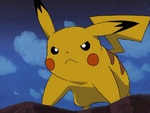Cloning: Difference between revisions
m (→In the games) |
No edit summary |
||
| (20 intermediate revisions by 10 users not shown) | |||
| Line 1: | Line 1: | ||
{{search|process of genetic duplication|the glitch| | {{search|process of genetic duplication|the glitch|cloning glitches}} | ||
'''Cloning''' is a process that creates a genetic duplicate of a being that is or was alive. | {{incomplete|needs=images}} | ||
'''Cloning''' is a process that creates a genetic duplicate of a being that is or was alive. | |||
== | ==In the anime== | ||
{{ | [[File:Clone Balls anime.png|thumb|200px|right|The [[Poké Ball]]s in which Mewtwo contained its cloning targets]] | ||
Cloning has appeared a few times in the anime. Its most prominent appearance is in ''[[M01|Mewtwo Strikes Back]]''. | |||
In ''[[The Uncut Story of Mewtwo's Origin]]'', [[Dr. Fuji]] creates {{p|Mewtwo|an enhanced clone of Mew}} as requested by {{an|Giovanni}} in exchange for funding his primary project, a (failed) attempt to clone his dead daughter {{an|Amber}}, and three test clones of the [[Kanto]] [[starter Pokémon]]. | |||
In ''Mewtwo Strikes Back'', {{OBP|Mewtwo|original series}} itself makes clones (Japanese: '''コピーポケモン''' ''Copy Pokémon'') of various Pokémon belonging to the Trainers who have come to [[New Island]]. Mewtwo captures the target Pokémon in special [[Poké Ball]]s—even those currently in their Poké Balls can be caught by these—then sends these Balls through a special cloning machine. All of Mewtwo's clones appear to have been created fully-grown, unlike Fuji's clones. All cloned Pokémon—excluding Mewtwo—appear identical to a normal Pokémon of their species, though a few of the clones have multiple black horizontal marks on their bodies. | |||
Mewtwo's clones are also featured in ''[[Mewtwo Returns]]''. | |||
Cloning also plays a role in ''[[M16|Genesect and the Legend Awakened]]'', in which both [[Mewtwo (Best Wishes series)|another Mewtwo]] and [[Genesect Army|a group]] of {{p|Genesect}} were cloned, the former from Mew's DNA by an [[Mewtwo's creators|unknown group]] and the latter from fossils by [[Team Plasma]]. | |||
== | ===Cloned Pokémon seen in the anime=== | ||
{| width="100%" | |||
|- | |||
| {{InactivePoké|Mewtwo|Mewtwo|Mewtwo M01.png|Psychic|link=Mewtwo (original series)}} | |||
| {{InactivePoké|Mewtwo|Bulbasaur|Kanto Starter Clones.png|Grass|Poison|link=no|nick=Bulbasaurtwo}} | |||
| {{InactivePoké|Mewtwo|Charmander|Kanto Starter Clones.png|Fire|link=no|nick=Charmandertwo}} | |||
| {{InactivePoké|Mewtwo|Squirtle|Kanto Starter Clones.png|Water|link=no|nick=Squirtletwo}} | |||
|- | |||
| {{InactivePoké|Mewtwo|Pikachu|Pikachutwo.png|Electric|link=Pikachutwo|nick=Pikachutwo}} | |||
| {{InactivePoké|Mewtwo|Venusaur|Venusaur Clone.png|Grass|Poison|link=no|nick=Venusaurtwo}} | |||
| {{InactivePoké|Mewtwo|Charizard|Charizard Clone.png|Fire|link=no|nick=Charizardtwo}} | |||
| {{InactivePoké|Mewtwo|Blastoise|Blastoise Clone.png|Water|link=no|nick=Blastoisetwo}} | |||
|- | |||
| {{InactivePoké|Mewtwo|Meowth|Meowthtwo.png|Normal|link=no|nick=Meowthtwo}} | |||
| {{InactivePoké|Mewtwo|Psyduck|none.png|Water|link=no}} | |||
| {{InactivePoké|Mewtwo|Vulpix|Mewtwo Clones.png|Fire|link=no}} | |||
| {{InactivePoké|Mewtwo|Gyarados|Mewtwo Clones.png|Water|Flying|link=no}} | |||
|- | |||
| {{InactivePoké|Mewtwo|Seadra|none.png|Water|link=no}} | |||
| {{InactivePoké|Mewtwo|Nidoqueen|Mewtwo Clones.png|Poison|Ground|link=no}} | |||
| {{InactivePoké|Mewtwo|Golduck|Mewtwo Clones.png|Water|link=no}} | |||
| {{InactivePoké|Mewtwo|Tentacruel|none.png|Water|Poison|link=no}} | |||
|- | |||
| {{InactivePoké|Mewtwo|Vaporeon|Mewtwo Clones.png|Water|link=no}} | |||
| {{InactivePoké|Mewtwo|Pidgeot|none.png|Normal|Flying|link=no}} | |||
| {{InactivePoké|Mewtwo|Scyther|none.png|Bug|Flying|link=no}} | |||
| {{InactivePoké|Mewtwo|Hitmonlee|none.png|Fighting|link=no}} ♂ | |||
|- | |||
| {{InactivePoké|Mewtwo|Sandslash|Mewtwo Clones.png|Ground|link=no}} | |||
| {{InactivePoké|Mewtwo|Dewgong|none.png|Water|Ice|link=no}} | |||
| {{InactivePoké|Mewtwo|Rhyhorn|Mewtwo Clones.png|Ground|Rock|link=no}} | |||
| {{InactivePoké|Mewtwo|Wigglytuff|Mewtwo Clones.png|Normal|link=no}} | |||
|- | |||
| {{InactivePoké|Mewtwo|Vileplume|Mewtwo Clones.png|Grass|Poison|link=no}} | |||
| {{InactivePoké|Mewtwo|Ninetales|Mewtwo Clones.png|Fire|link=no}} | |||
| {{InactivePoké|Mewtwo|Rapidash|Mewtwo Clones.png|Fire|link=no}} | |||
|} | |||
==Trivia== | |||
[[File:Baby Nidoqueen and Baby Rhyhorn.png|thumb|200px|left|Baby clone Nidoqueen and Rhyhorn]] | |||
{{Bulbanews|Unused Pokémon design revealed in magazine interview}} | |||
* In an interview with @Gamer magazine, [[Junichi Masuda]] and [[Ken Sugimori]] revealed that there was originally going to be a Pokémon based on {{wp|Dolly (sheep)|Dolly}}, the first cloned sheep, but was deemed "too controversial." | |||
* In the anime, cloned Pokémon appear to be fertile, even those that would normally not be. Baby {{p|Rhyhorn}} and {{p|Nidoqueen}} (not {{p|Nidoran♀}}) are seen in ''[[Mewtwo Returns]]''. | |||
[[Category:Pokémon world]] | [[Category:Pokémon world]] | ||
[[de:Klone]] | |||
[[it:Clonazione]] | |||
Revision as of 11:51, 2 December 2014
- This article is about the process of genetic duplication. For the glitch, see cloning glitches.

|
This article is incomplete. Please feel free to edit this article to add missing information and complete it. Reason: images |
Cloning is a process that creates a genetic duplicate of a being that is or was alive.
In the anime

Cloning has appeared a few times in the anime. Its most prominent appearance is in Mewtwo Strikes Back.
In The Uncut Story of Mewtwo's Origin, Dr. Fuji creates an enhanced clone of Mew as requested by Giovanni in exchange for funding his primary project, a (failed) attempt to clone his dead daughter Amber, and three test clones of the Kanto starter Pokémon.
In Mewtwo Strikes Back, Mewtwo itself makes clones (Japanese: コピーポケモン Copy Pokémon) of various Pokémon belonging to the Trainers who have come to New Island. Mewtwo captures the target Pokémon in special Poké Balls—even those currently in their Poké Balls can be caught by these—then sends these Balls through a special cloning machine. All of Mewtwo's clones appear to have been created fully-grown, unlike Fuji's clones. All cloned Pokémon—excluding Mewtwo—appear identical to a normal Pokémon of their species, though a few of the clones have multiple black horizontal marks on their bodies.
Mewtwo's clones are also featured in Mewtwo Returns.
Cloning also plays a role in Genesect and the Legend Awakened, in which both another Mewtwo and a group of Genesect were cloned, the former from Mew's DNA by an unknown group and the latter from fossils by Team Plasma.
Cloned Pokémon seen in the anime
Trivia
- In an interview with @Gamer magazine, Junichi Masuda and Ken Sugimori revealed that there was originally going to be a Pokémon based on Dolly, the first cloned sheep, but was deemed "too controversial."
- In the anime, cloned Pokémon appear to be fertile, even those that would normally not be. Baby Rhyhorn and Nidoqueen (not Nidoran♀) are seen in Mewtwo Returns.










